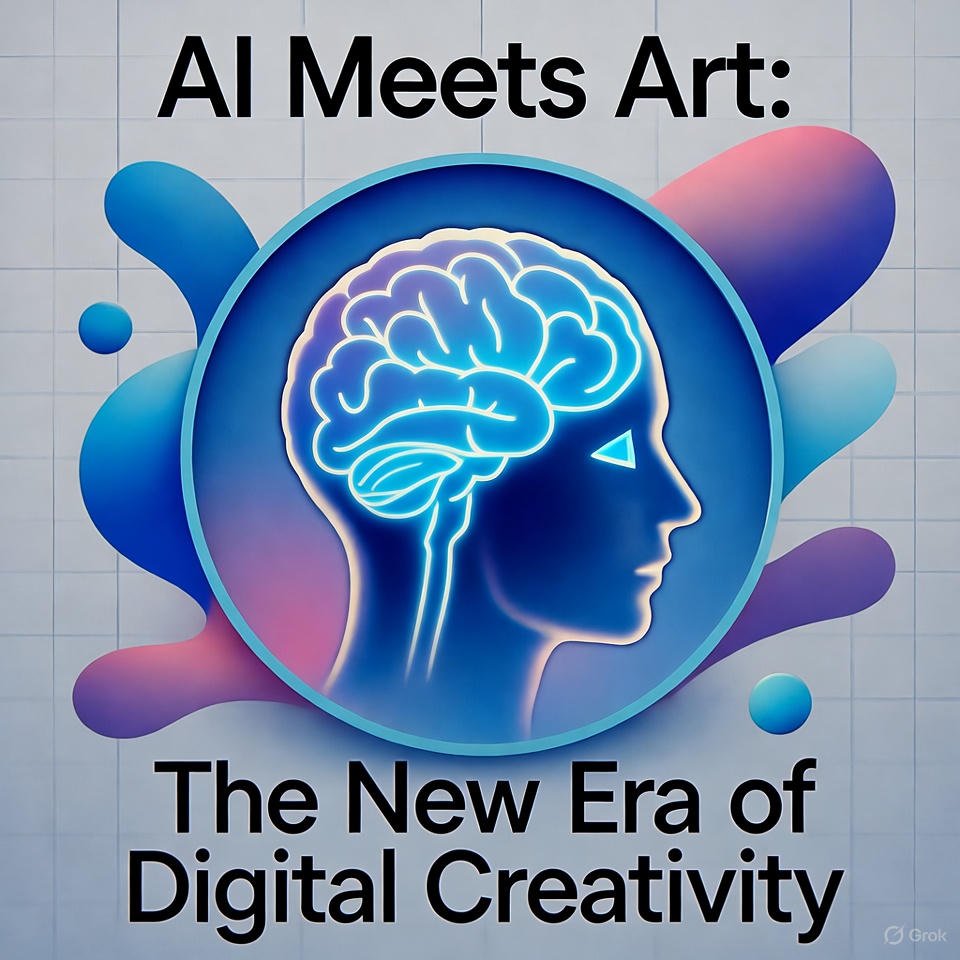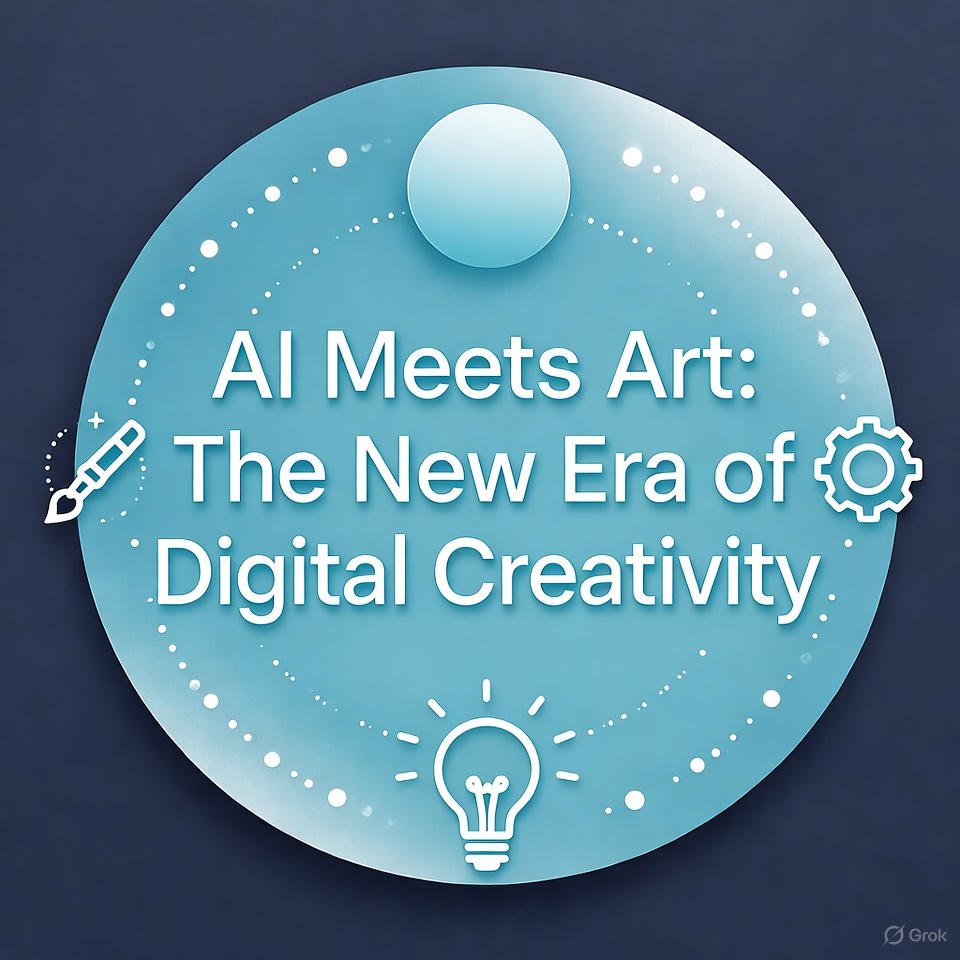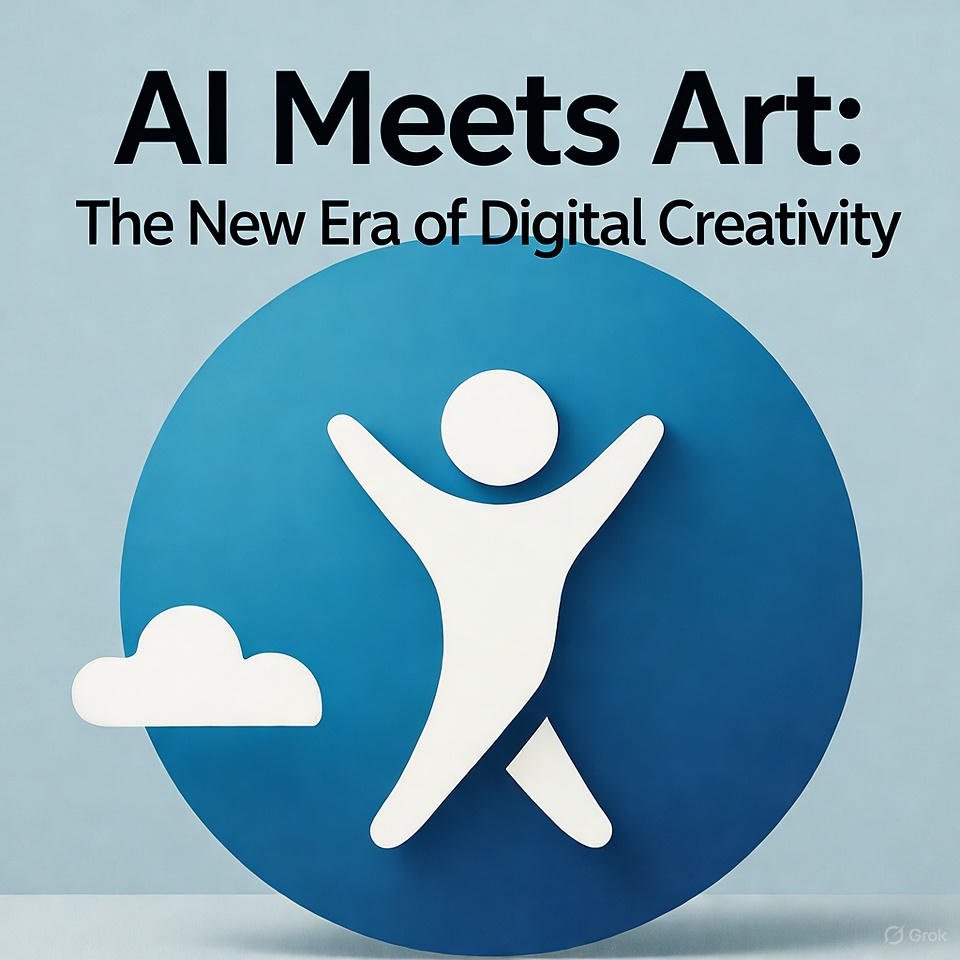
Introduction
Imagine an artist’s studio where the muse whispers in code, where brushstrokes are partly driven by algorithms, and where a collaboration between human intuition and machine logic yields something wholly unexpected. Welcome to the new era of digital creativity, where AI meets art in bold, beautiful, and sometimes surprising ways.
In this post, we’ll explore how artificial intelligence is reshaping the artistic landscape, from generative art and neural-style transfers to immersive installations and everyday creative tools. We’ll look at real examples, practical tips, and thoughtful reflections on what it means to be creative in an age when machines can “paint,” “compose,” or “design.” Whether you’re an artist curious about AI, a designer experimenting with new tools, or simply someone fascinated by the crossover between tech and creativity—you’re in the right place.
Let’s dive in.
1. Why AI + Art? The Promise and the Possibility
1.1 A shortcut, collaborator, or challenger?
When people first hear “AI art,” they often think of robots taking over creativity. But in reality, AI in the art world is more often a:
- Shortcut — automating tedious tasks (e.g. background removal, colorizing, upscaling resolutions)
- Collaborator — offering suggestions, proposals, or co-creation with human artists
- Challenger — pushing boundaries by generating novel forms, prompting new questions about authorship and aesthetics
It’s not about replacing artists, but about expanding creative possibilities.
1.2 The technological foundations
AI-driven art largely rests on advances in:
- Generative models: Generative Adversarial Networks (GANs), Variational Autoencoders (VAEs), diffusion models, and transformer-based architectures
- Neural style transfer and texture synthesis: mapping one style onto another
- Reinforcement learning and interactive systems: for generative installations or real-time art systems
- Computer vision and perception: allowing systems to “see” and respond to visual cues
These technologies give machines a rough “sense” of form, style, texture, and variation—and allow them to propose unexpected creative paths.
1.3 Why now?
Several converging trends make this moment especially fertile:
- The availability of high-powered GPUs, tensor processing units (TPUs), and cloud computing
- Large open datasets of images, music, and text
- Open-source frameworks like TensorFlow, PyTorch, RunwayML, and others
- A growing interest from creative communities and brands, eager to experiment
Put simply: the barriers to entering AI art are lower than ever before.
2. Emerging Trends & Compelling Examples
Let’s get inspired by what’s already happening at the frontier of AI + art.
2.1 Generative Portraits & Faces
- This Person Does Not Exist: A website that showcases hyperrealistic faces created by GANs—none of which correspond to real people.
- Refik Anadol’s Memory Machines: Using AI to construct abstract, dream-like portraits tethered to archives or memory data.
- Creative Portrait Apps: Tools like Artbreeder let users breed images, remix faces or landscapes in real time.
These systems probe identity, realism, and how we perceive human features when composed by algorithms.
2.2 Style Transfer & Remixing
- DeepArt, Prisma, and Deep Dream: Algorithms take your photo and re-render it in the style of van Gogh, Picasso, or abstract motifs.
- Google’s DeepDream: A psychedelic twist on convolutional neural networks, creating surreal, dreamlike images.
- MuseNet & Jukebox: Music-style “transfer”—using AI to recompose audio in the style of other genres or artists.
Remixing isn’t plagiarism; it’s reinterpretation—and AI offers new paths to remix.
2.3 Immersive & Interactive AI Installations
- TeamLab Borderless (Tokyo): A museum where visuals respond to human motion, offering shifting AI-driven vistas.
- Random International’s Rain Room: While not purely AI, recent iterations have incorporated AI elements reacting to visitors in real time.
- More Than Us by Refik Anadol: A living data-driven sculpture where AI sculpts space in reaction to visitor presence.
Here, AI is less a “painter” and more a responsive collaborator in space, sound, and movement.
2.4 AI-driven Tools in Creative Workflows
- Adobe Sensei: Offers auto-masking, content-aware fills, intelligent selections.
- AutoDraw by Google: AI guesses what you’re doodling and gives clean vector alternatives.
- RunwayML: A toolkit for creators to apply ML models, generate content, and integrate AI into creative pipelines with minimal code.
- DALL·E, Midjourney, Stable Diffusion (text-to-image generators): Given a textual prompt, these systems produce images that align with descriptive language.
Rather than being isolated art projects, these tools plug into existing workflows, giving artists new brushes in their toolkits.

3. How to Experiment (Even with No Coding Skills)
You don’t need to be a deep learning researcher to explore AI art. Here’s a beginner-friendly path:
3.1 Choose your domain
Decide whether you want to explore:
- Visual art / images / generative visuals
- Audio / music / generative sound
- Text / poetry / narrative art
- Interactive installations / mixed media
You’ll choose tools and methods appropriate to the domain.
3.2 Try no-code/non-technical platforms first
- RunwayML – Apply pre-trained models, experiment with generative styles, export results.
- Artbreeder – Browse, mix, “breed” images via intuitive sliders.
- DeepArt / Prisma – Style transfer on your photos.
- NightCafe, Dream by Wombo – Prompt-based image generation for casual experiments.
- Amplitude Studios’ AI Playground – Tools for generating textures or 3D assets.
These let you tinker, learn, and play—without ever touching Python.
3.3 Gradually dip into code & models
Once comfortable, consider:
- Using open-source models
- Download Stable Diffusion, VQGAN+CLIP, or StyleGAN models
- Train or fine-tune on your own dataset
- Use notebooks like Colab to run experiments
- Data curation & preprocessing
- Assemble a small, curated dataset (e.g. 500–1,000 images)
- Clean, normalize, and annotate
- Train / fine-tune for specific styles or domains
- Human-in-the-loop workflows
- Use AI outputs as drafts
- Iterate, refine, retouch, or “guide” the model
- Blend human edits + AI suggestions
3.4 Practical tips to get meaningful output
- Start small: Use modest resolution, fewer training epochs
- Limit your search space: Use constraints or steerable controls
- Seed your randomness: Use random seeds to reproduce promising outputs
- Iterate fast: Treat AI output as rough drafts, not final art
- Filter & curate: Only select strong results—many will be odd or unusable
- Give credit: Document your datasets, models, and human edits
4. Challenges, Considerations & Ethical Questions
AI art is exciting—but it raises real challenges. Let’s walk through the key ones.
4.1 Authorship & ownership
- Who owns an artwork generated by AI? The user? The model creator? The data curator?
- Some jurisdictions have rejected copyright eligibility for purely machine-generated works.
- Best practice: maintain clear records of your inputs, model versions, edits, and prompts.
4.2 Bias, plagiarism, & data provenance
- Models trained on biased datasets may perpetuate bias (e.g. skewed representations of ethnicity, gender, culture).
- Some AI art systems inadvertently replicate parts of their training data (raising plagiarism concerns).
- Always vet your training data, or use models with transparent licensing.
4.3 Quality vs. novelty
- Early AI art often produced uncanny, distorted, or “glitchy” outputs.
- Newer models are better, but sometimes less surprising.
- The real creative payoff lies in human–AI synergy: human curation, selection, intervention.
4.4 Accessibility & inequality
- Large models and compute resources are expensive.
- Artists or institutions with access to resources may dominate the field.
- Open-source efforts, GPU grants, and community initiatives help—but inequality remains.
4.5 The “AI aesthetic” trap
- There’s a temptation to default to what “looks like AI art” (e.g. ethereal scenes, ghostly faces, color gradients).
- Resist that trap: use AI as a tool, not a style. Let your human aesthetic drive choices.
5. Practical Use Cases & Real-World Projects
Let’s look at how artists, designers, and brands are putting AI + art into practice.
5.1 Commercial design & advertising
- Nike, Gucci, and Adidas have used generative AI in campaigns, customizing visual assets at scale.
- Logo design tools integrate AI to propose brand marks based on keywords or moods.
- Print-on-demand systems generate unique patterns or textures for clothing, packaging, or merchandise.
These examples show how AI can speed ideation cycles and enable mass personalization.
5.2 Art exhibitions & galleries
- The auction house Christie’s sold an AI-generated artwork, Portrait of Edmond de Belamy, for $432,500 (2018).
- Galleries now host immersive AI art shows, letting visitors walk through evolving algorithmic canvases.
- Museums use AI to restore or imagine “lost” art fragments (e.g. reconstructing missing frescoes or damaged archives).
5.3 Interactive media & installations
- AI-driven theater or dance: projections that respond to performers in real time.
- Generative audio-visual concerts: visuals shaped by live music, AI-guided visuals adapting to sound.
- Digital games & virtual reality: environments that evolve differently each playthrough using procedural AI.
5.4 Education & democratization
- Art schools integrate AI modules into curricula.
- Platforms teach artists how to fine-tune models and explore generative art.
- Hackathons and creative AI jams let novices experiment and collaborate.
These use cases help bridge the gap from novelty to sustained practice.
6. How to Evaluate & Curate AI Art
As more people create AI art, we’ll need standards of taste and critique. Here are principles to guide evaluation.
| Criteria | Questions to Ask | What to Look For |
|---|---|---|
| Conceptual depth | Why is this made? What does it say? | The idea or vision should resonate beyond the “wow” factor. |
| Visual coherence & craftsmanship | Does it look intentional, polished? | Smooth transitions, thoughtful composition, control over artifacts. |
| Novelty & surprise | Does it offer something unexpected? | Fresh forms, interesting distortions, metaphorical twists. |
| Human–AI dialogue | How visible is the human hand? | Good art often shows visible human intervention or editing. |
| Sustainability & ethics | Is the process fair, transparent, responsible? | Credible documentation, licensing, thoughtful sourcing. |
When you look at an AI piece, ask: What would I lose if the AI hand was removed entirely? The answers often reveal the artistic core.
7. Tips for Building Your Own AI + Art Project
If you’re ready to start your own AI art venture, here are actionable steps and tips.
7.1 Define your question or intent
- What do you want to explore (form, identity, movement, memory)?
- Who is your audience (gallery, web, installation, social media)?
A good project starts with a concept—not just “I want to make AI art.”
7.2 Start with a small pilot
- Run a low-resolution experiment, just to test your pipeline.
- Use off-the-shelf models before training your own.
- Iterate rapidly, discard what doesn’t work.
7.3 Keep a “sketchbook” of outputs
- Save dozens or hundreds of AI-generated drafts.
- Annotate which ones you like, why, and what could be improved.
- Over time, patterns emerge in what resonates with your taste.
7.4 Blend across media
- Overlay AI visuals with hand-drawn elements.
- Map visuals to sound or motion.
- Use AI output as a substrate, then rework, collage, or recombine.
7.5 Engage in community & critique
- Share your experiments (even flawed ones)—feedback helps refine.
- Join AI art communities (Discords, Reddit, forums).
- Collaborate with engineers, code-savvy creators, or traditional artists.
7.6 Document everything
- Record your prompts, model versions, seed values.
- Keep track of sources and licensing.
- When showing or selling the work, transparency boosts trust.

8. The Future of AI & Art: Speculations & Possibilities
What might come next as this field evolves? Here are some visions and questions to watch.
8.1 Hyper-personalized creative assistants
Imagine an AI companion trained on your artwork, voice, visual taste, that can generate sketches, palettes, or musical motifs personalized for you.
8.2 Multimodal creativity becomes seamless
You could say: “Make me a visual poem about monsoon in Mumbai,” and get a multimedia piece (image + text + audio) in one go.
8.3 Democratization at scale
Imagine community-driven AI labs, local compute hubs, or open-source models fine-tuned on local cultural datasets—bringing AI art to underrepresented regions.
8.4 New art forms we’ve never seen
As AI becomes more expressive and autonomous, entirely new aesthetic forms could emerge—algorithms that evolve over time, art that “ages,” systems that co-create with audiences live.
8.5 The ethics frontier
- Regulatory frameworks for AI-generated art
- Value systems around AI-generated creativity
- Questions about authenticity, originality, and cultural appropriation
The art world’s boundaries—legal, conceptual, cultural—will likely shift in the coming decades.
Conclusion
We are witnessing a creative renaissance: AI is not a usurper of artistry, but a new kind of brush, a co-creator, a provocateur. The intersection of human intuition and algorithmic complexity yields work that can delight, challenge, and inspire.
Some key takeaways:
- AI art is collaborative: Think of AI as a creative partner, not a replacement.
- Start simple: Use no-code tools, experiment freely, learn by doing.
- Curate and intervene: The human hand matters; editing, selection, and concept turn raw outputs into art.
- Be ethical and transparent: Understand data provenance, credit, and machine biases.
- Stay curious and adaptable: The field is evolving rapidly; the next breakthrough could be yours.
In this new era, artistry is not passive consumption or mimicry—but active conversation with machines. When we learn to listen, to guide, and to challenge, we may discover new forms of beauty beyond what either humans or machines could have achieved alone.